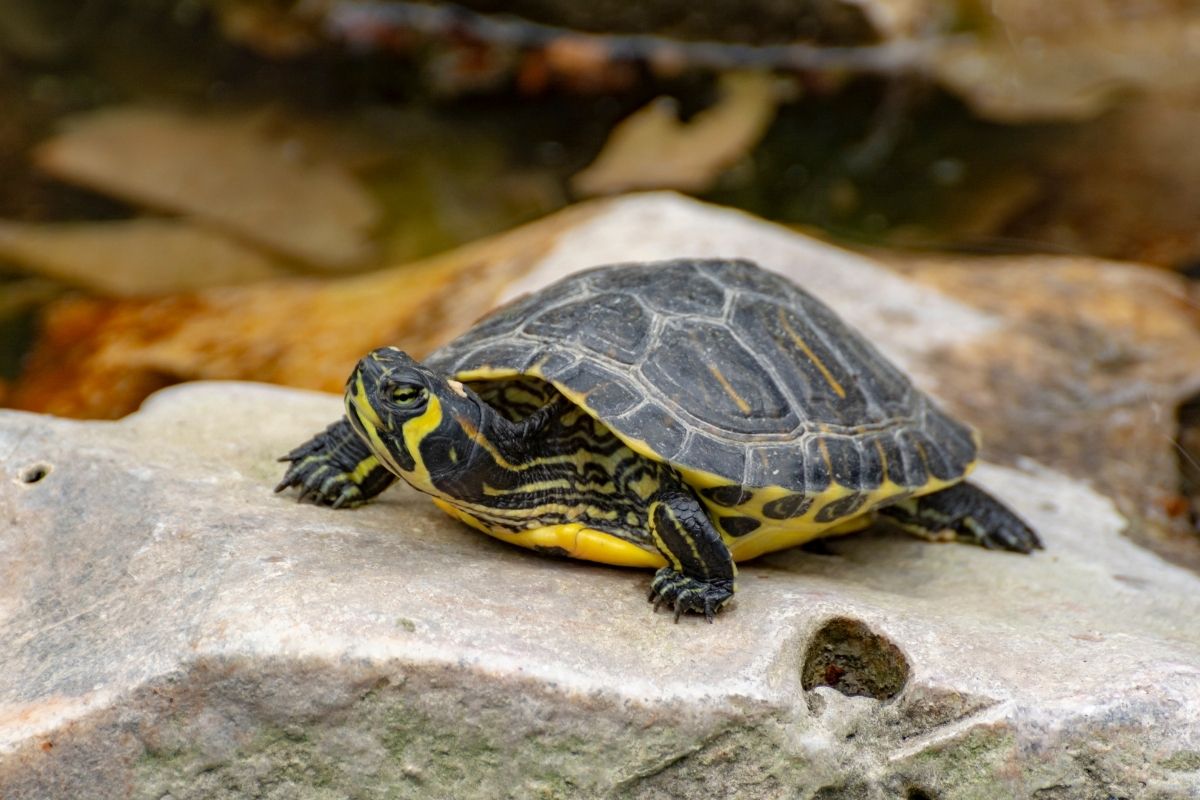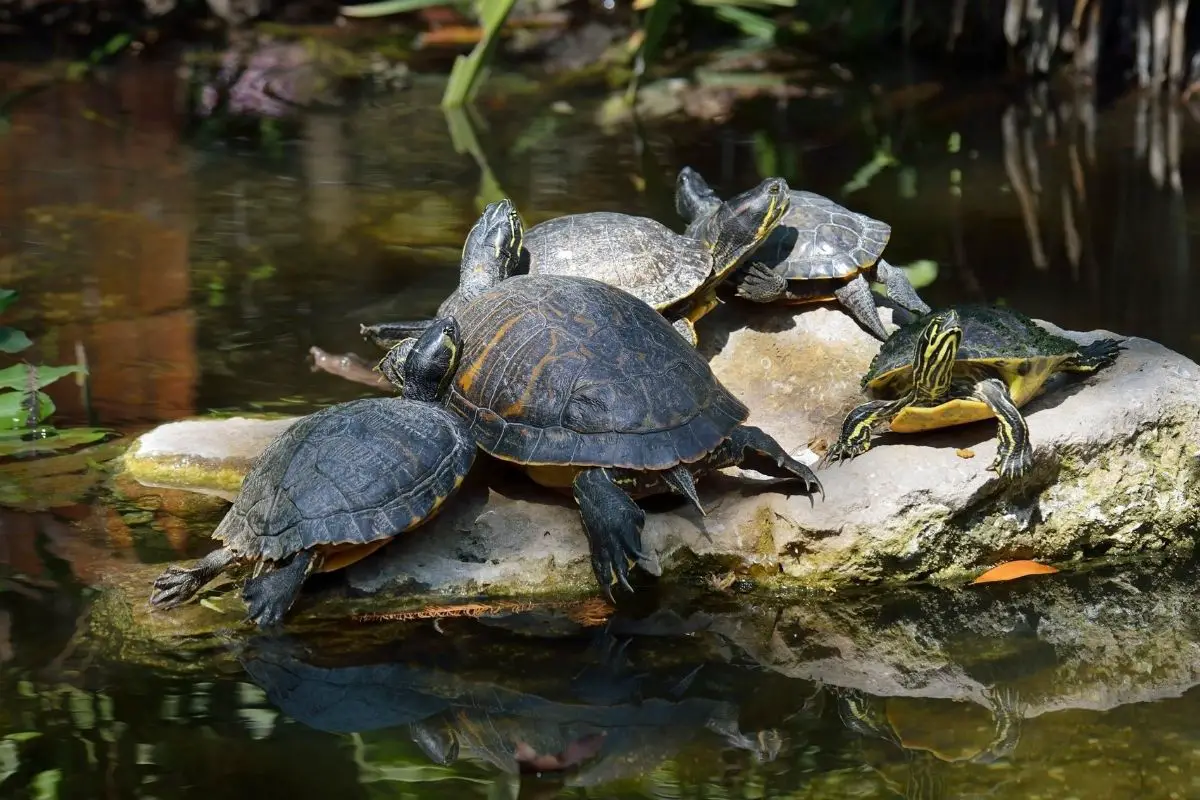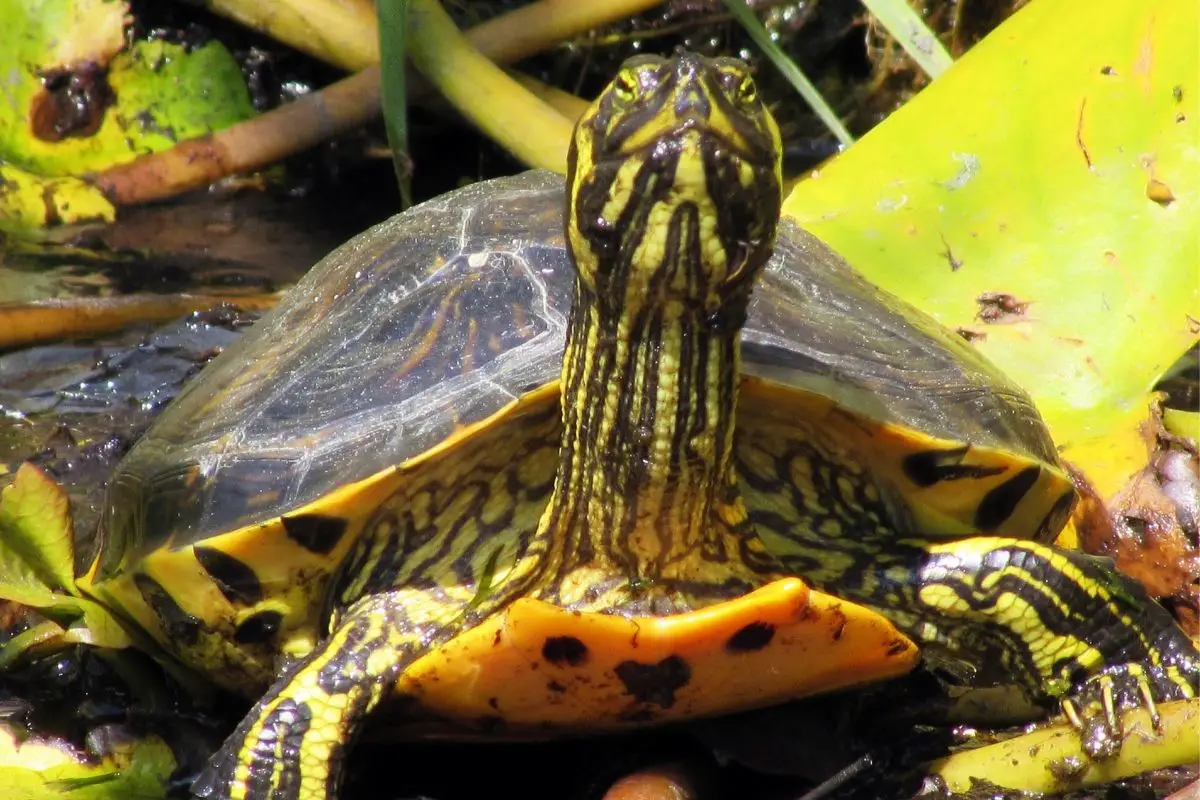One of the most popular types of turtles to keep at home as a pet is a yellow-bellied slider. Now you may not think that it makes much difference in terms of having a female or a male yellow-bellied slider.

However, when it comes to caring for their needs, it will be important to know the difference between the two and which one you have in your tank.
At first glance, it can be really tricky to tell the difference between a female and male yellow-bellied slider. But it is much easier to tell the difference than you first think.
You can mostly tell from their appearance, as the females are larger than the males, and they also tend to be more colorful than male yellow-bellied sliders.
You will also notice that female turtles will have much shorter claws than their male counterparts.
The two also have different positioning when it comes to their cloaca, with females having this much further along the base of their tails.
Today, we are going to cover all of these factors in more detail so that you can easily identify the difference between female and male yellow-bellied sliders.
By the end of this article, you are going to be an expert on deciphering between the two sexes.
The only thing to bear in mind is that the determining factors are mostly more notable as your turtle ages. If they are younger than 1 year of age, it will be much trickier to work out which gender they are.
Take A Look At The Cloaca Positioning
The first thing to consider when determining the sex of your turtle is to find the positioning of their cloaca.
This is the small hole usually located on their tail, which allows your turtle to breathe when they are underwater. It can also be used for other things, such as laying eggs.
Every single yellow-bellied slider will have a cloaca, and it is the positioning of this that will help you to determine the sex of your turtle.
This is because the cloaca is located towards the tip of the tail for males, whereas females have it placed closer to the base of their tail.
So because they are positioned in such different areas of a turtle’s tail, it can be a dead giveaway as to what the sex of the turtle in question is.
How Long Are Your Yellow-Bellied Slider’s Claws?
The length of the claws of your turtle is another obvious sign of what their sex is.
This is because male yellow-bellied sliders tend to have much larger claws than their female counterparts.
This is because these longer claws are used to help them attract a mate and help the male climb on top of their female partner when they want to create baby yellow-bellied sliders.
Females have much smaller claws than their male counterparts because they don’t need them to be longer for practical reasons.
So if you notice that your turtle’s claws are long or short, this should give you a better idea of whether they are a male or a female.
What Is The Shape And Length Of Your Yellow-Bellied Slider’s Tail?

Don’t want to get up close and personal with your turtle to look at their cloaca or the length of their claws? Then your next best bet will be to look at the shape and length of their tail.
This is because females and males have different tails from one another.
Whereas females tend to have denser, shorter tails, males typically have thin, long tails.
So getting a better look at the tail of your yellow-bellied slider should help you to identify which gender they are, especially when comparing this with the other factors we have mentioned.
If they have a thinner tail, chances are then they are male. If the yellow-bellied turtle has a thicker tail, then it is a female.
What Is The Shape Of The Plastron?
Next, you will need to take a look at the shape of the turtle’s plastron and carapace.
In other words, you’ll need to take a look at the shape of your yellow-bellied slider’s shell! Interestingly, only the plastron part of the shell usually differs in size.
The plastron is the part of the shell that is underneath your turtle. The part of the shell on the top of your turtle’s back is known as the carapace.
If you gently lift your yellow-bellied slider, you should see a noticeable difference in the shape of the plastron.
With females, the plastron is typically flat. This allows them more room so that they can carry more eggs inside their shells. However, males have a slightly concave plastron.
This is because the slightly concave plastron allows the males to climb onto their female partners for mating purposes more easily.
How Large Is Your Turtle?
Lastly, you will need to take a look at the overall size of your yellow-bellied slider.
Along with all the factors that we have covered in more detail above, this allows you to better identify whether your turtle is male or female.
As with most animals, the female yellow-bellied slider is actually much larger than the male.
They tend to measure around 12 to 14 inches in length, whereas the smaller males only reach a length of around 8 to 10 inches.
Understandably, it will be much easier to use this size comparison method if you have both a female and a male turtle who are around the same age.
So if you have two turtles that were born around the same time, but one is much larger than the other one, you can safely assume that this larger turtle is a female.
You can also use a soft tape measure to work out whether you have a female or a male if you only have one yellow-bellied slider. Measure your turtle’s shell from near their head to near their tail.
If you have a turtle that is larger than 10 inches, you will know that you have a female yellow-bellied slider. If it is around 10 inches or smaller, then you will know you have a male turtle.
What Color Is Your Yellow-Bellied Slider?
Another factor that you can use to decipher whether you have a female or a male yellow-bellied slider is to examine the color of your pet.
Now this will only really be a reliable factor to use as your turtle grows older. This is because as your turtle ages, its colors start to darken.
You will definitely notice the difference with your male yellow-bellied slider, as they tend to darken a lot more than the female turtles.
We’ve mentioned this factor last because it won’t be too reliable for younger turtles. For most of their lives, both your female and male turtles will have very similar coloring.
It will only be when they start to enter the last few years of their lifespan that the males’ shells will start to darken.
Do You Have To Care For Female And Male Yellow-Bellied Sliders Differently?

So what about when it comes to caring for your yellow-bellied slider turtles? Are there many differences between caring for the two genders?
The good news is that there aren’t that many differences. However, there are one or two that will be worth bearing in mind.
The most obvious one, of course, is that a female yellow-bellied turtle is going to be laying eggs, whereas the males won’t. The female turtle will still lay eggs even if she hasn’t been fertilized.
The only thing you will need to do in this case is throw out the unfertilized eggs, and make sure to keep an eye on your female turtle. She may have more eggs to lay after the first initial batch.
If you have a male in the tank with her and want to try to breed your own turtles, it would be best to look at this topic in more detail first.
This is because you will need to buy special equipment in order to do this.
The only other difference in caring for your female turtle is that she will need to eat more food because of her larger size.
Aside from these two differences, there won’t be much else to consider between caring for a male and female yellow-bellied turtle. If you don’t want the hassle of looking for eggs occasionally, it may be best to opt for a male turtle.
Frequently Asked Questions
What Is The Lifespan Of A Yellow-Bellied Slider?
The average lifespan of a yellow-bellied slider turtle is anything between 30 and up to a whopping 50 years of age. If left out in the wild, this average lifespan would dip to around 25 to 30 years.
This is primarily because out in their natural habitat, there are, of course, predators and other factors which will come into play.
When yellow-bellied turtles are kept as pets, they are well cared for and have a ready supply of food.
This can help to increase their average lifespan, as they have everything they need to live long and happy lives right here in the tank with them.
It will be worth considering this long lifespan when it comes to choosing a yellow-bellied turtle for a pet. You will need to consider this commitment seriously and ensure that you can give your yellow-bellied slider the care and attention that they need to thrive.
Do Yellow-Bellied Sliders Actually Sleep Underwater?
Yes, these turtles are actually able to sleep when they are underwater!
In fact, whereas you might think that they would prefer to sleep under a warm light, they actually prefer to sleep under the water.
What is fascinating about this is that their metabolic rate actually drops when they start to sleep underwater. This allows them to remain under the surface for longer periods of time before they need to wake up and go in search of food.
This is partly evolutionary, as underwater is one of the safest places for yellow-bellied sliders to sleep in the wild. It gives them a natural hiding place from predators, where they aren’t likely to be spotted.
As we’ve discussed above, this is where the cloaca will come in handy!
Whereas breathing naturally only allows them to remain underwater for around half an hour to 45 minutes, when sleeping, these turtles will use their cloaca to breathe.
This type of respiration will actually allow the turtle to stay under the surface for an impressive 6 to 8 months in the case of hibernation.
What Quantity Of Water Is Needed In A Tank For A Yellow-Bellied Slider?
Of course, you will want to keep your yellow-bellied slider turtle happy and healthy in its new tank.
So you should use the general rule of thumb that for each inch of their shell, they will have at least 10 gallons of water.
Does your yellow-bellied slider measure around 4 inches in length? Then they will need to have a minimum of around 40 gallons of water in their tank.
This should make it super easy to work out how much water your turtle will need in their tank.
So if you have a female turtle, she will need a lot more water than a male turtle because they generally tend to be larger turtles. You will also have to adjust this amount over time as your younger turtle grows older.
In Summary
So there you have it! Even though all yellow-bellied sliders may appear to be exactly the same at first glance, with just a little more inspecting, you can easily tell the difference between female and male turtles.
There are several factors that you can use to determine whether you have a female or male, including the size of their shell, the shape and length of their tail, the length of their claws, the position of their cloaca, what shape their plastron is, and as the turtle gets older, what color their shell is.
Adult females tend to have a cloaca placed towards the base of their tails. They have thicker tails which are much smaller than the male’s tail, and have much shorter claws.
They have a flat plastron, which gives them more room for eggs when they are gravid. Female sliders are also larger than males, measuring around 12 to 14 inches in length.
Adult males are smaller than their female counterparts, measuring around 8 to 10 inches in length. They have longer claws, as well as a concave plastron, which aids them when it comes to mating.
They also have a thinner, longer tail than the females, with the cloaca positioned further along with this. Males also tend to darken as they get older.
Using all of these factors should help you to work out whether you have a female or male yellow-bellied slider or even tell the difference between the two.
